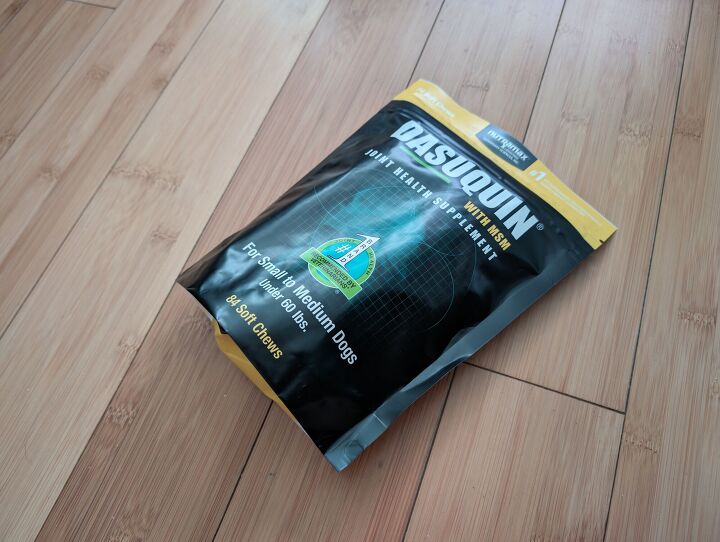Can You Prevent Joint Pain in Dogs?

As dogs near their golden years, different health issues tend to pop up – sometimes completely out of the blue, and sometimes a little less unexpectedly. One of the more common health problems dogs experience as they age that can be predicted fairly easily and as such prevented on time are joint issues. Providing proper support for your dog while they are still young and agile can dramatically improve their quality of life later on, so it pays to start thinking ahead when it comes to joint health, especially if your pet is in a high-risk group for developing this type of problem (large breed dogs, working breeds, highly active dogs, etc). Here’s what you need to know to make sure your pet doesn’t suffer from joint pain in their senior years.
5 Crucial Steps to Prevent Joint Pain in Dogs
While some factors contributing to joint pain are beyond our control, there are different proactive steps we can take to support our pet's joint health:
#1 Maintain a Healthy Weight
Just as in humans, obesity in dogs exacerbates joint strain and can accelerate the onset of joint problems. A balanced diet will go a long way in helping your pet maintain a healthy weight, so strive to ensure they are getting only quality food that is based mostly on protein and doesn’t contain unhealthy fats and too many fillers such as soy or corn.
#2 Provide Regular Exercise
Moderate, low-impact exercise helps keep joints limber and muscles strong. However, be mindful of your dog's limitations, as pushing them too far can end up being counterproductive. Activities like swimming and walks are excellent choices, just make sure to tailor the pace to your pet’s capabilities.
#3 Quality Supplementation
Providing a diet rich in essential nutrients, including omega-3 fatty acids, glucosamine, and chondroitin, supports joint health. However, even when feeding a good quality kibble, it’s not always feasible to rely on your pet’s diet alone to be enough to provide all of these joint-nurturing ingredients in the right ratio. This is where dog joint supplements come in to enrich your pet’s diet with specific nutrients.
Dog joint supplements are available in the form of powders, drops, tablets, pills, etc, but one of the easiest ways to make sure your pet doesn’t avoid taking his supplement is by offering it as a treat. This is why I prefer chewable, flavored supplements such as Nutramax Dasuquin Hip & Joint Soft Chews. They are yummy (as my dog’s greedy grabbing would suggest) and contain everything your dog needs to keep their joints well lubricated, agile, and healthy for years to come, including glucosamine, chondroitin sulfate, ASU, and MSM in optimal ratios.
#4 Supportive Sleeping Surface
I know, I know – your dog prefers the living room sofa over their own bed. But while you can squeeze a snuggle when watching TV, you should redirect your dog to their bed when they sleep so they get proper support. As dogs spend up to 14 hours a day sleeping, it is essential that they spend that time on an orthopedic dog bed that will help relieve pressure on their joints. Also, you should avoid letting them sleep on hard surfaces and provide ramps or steps for easy access to higher areas, reducing the strain on their joints.
#5 Regular Veterinary Check-ups
Routine check-ups allow your veterinarian to detect early signs of joint issues and provide appropriate treatment or management strategies. They may recommend preventive measures such as joint supplements or physical therapy and ensure your pet is getting care tailored to their unique needs – they know their medical history and health status and will make the best treatment plan to suit your pet specifically.
What To Do If Your Dog Already Has Symptoms of Joint Issues?
Some of the more common indicators of joint issues in dogs include limping, reluctance to exercise, stiffness, and difficulty rising from a lying position. If you notice your dog struggling with any of the above, you should schedule a visit to the vet’s office to get the right diagnosis.
In case their joint issues are in a more advanced stage that can’t be helped with a lifestyle change and supplements, you can expect your veterinarian to recommend non-steroidal anti-inflammatory drugs for pain management, physical therapy, or even surgery for more severe cases.

A proud mama to seven dogs and ten cats, Angela spends her days writing for her fellow pet parents and pampering her furballs, all of whom are rescues. When she's not gushing over her adorable cats or playing with her dogs, she can be found curled up with a good fantasy book.
More by Angela Vuckovic
























